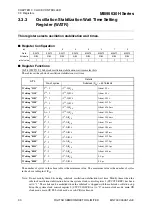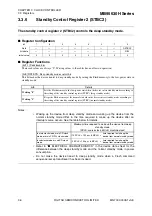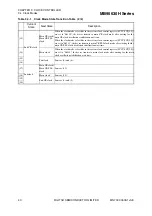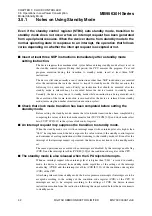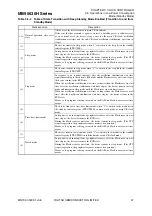
MB95630H Series
MN702-00009-1v0-E
FUJITSU SEMICONDUCTOR LIMITED
41
CHAPTER 3 CLOCK CONTROLLER
3.5 Operations in Low Power Consumption
Mode (Standby Mode)
3.5
Operations in Low Power Consumption Mode
(Standby Mode)
There are four standby modes: sleep mode, stop mode, time-base timer mode
and watch mode.
■
Overview of Transiting to and Returning from Standby Mode
There are four standby modes: sleep mode, stop mode, time-base timer mode, and watch mode.
The device transits to standby mode according to the settings in the standby control register
(STBC).
The device is released from standby mode by an interrupt or a reset. Before transiting to
normal operation, the device may wait for the oscillation stabilization wait time to elapse if
necessary.
When the clock mode returns from standby mode due to a reset, the device returns to main CR
clock mode. When the clock mode returns from standby mode due to an interrupt, the device
returns to the previous clock mode before transiting to standby mode.
■
Pin States in Standby Mode
The pin state setting bit (STBC:SPL) of the standby control register can be used to keep the
preceding state of an I/O port or a peripheral resource pin before its transition to stop mode,
time-base timer mode or watch mode, and to set an I/O port or a peripheral resource pin to high
impedance in stop mode, time-base timer mode or watch mode.
Refer to the device data sheet for the states of all pins in standby mode.




